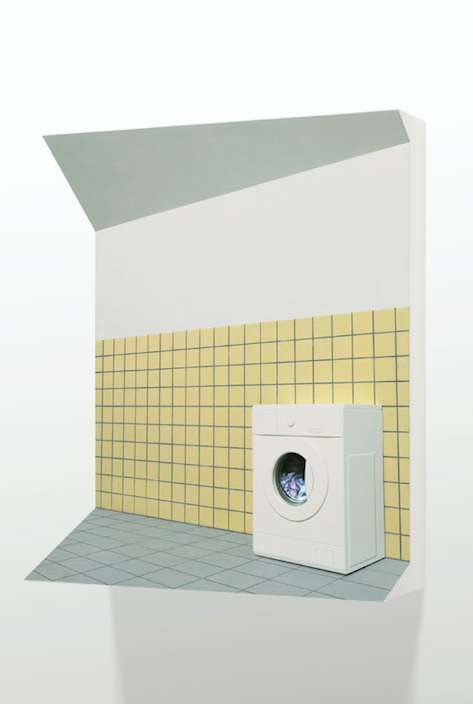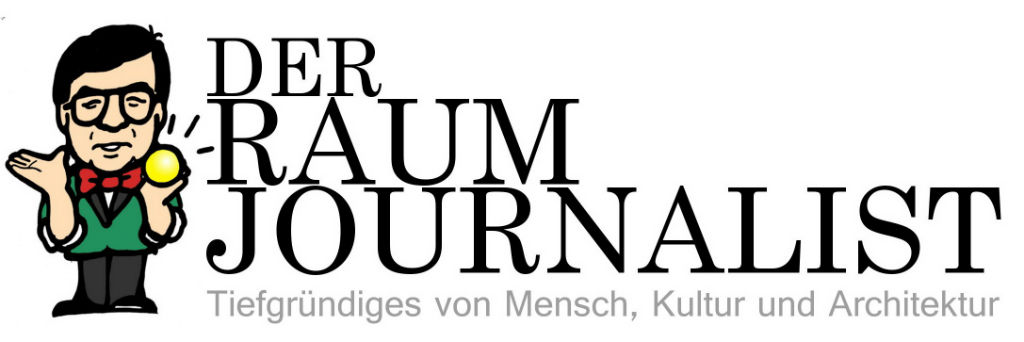ŌĆ£IŌĆÖm focussing on the human condition by investigating our boundaries.ŌĆØ INTERVIEW with Maurice van Tellingen
The historic peep box comes to mind. We looking on miniature scenes, your avarage every-day sceneries: a garage door, the pavement, all too functional interiors. Maurice van Tellingen’s objects are like stage sets of the every-day life, of reality as it might hit us on every corner. All too often these sceneries ooze desparation.

Garage, 2017, MDF, Alkyd Verf., 53 x 60 x 23 cm
This is what we are surrounding ourselves with. This is how we create “reality”. Architecture is – like clothing and artefacts – the “skin” that is covering us, the shelf we build around us. Our environment reflects who we are, says van Tellingen. In his objects, the artist investigates the human condition by exploring our boundaries. He tries to find out about the all-time philosophical question of human identity, who can I be, and he does so in investigating the constructs humans make to endure existence.
His models are still, no humans there, but the event, the story behind is inherent. The garage door slightly ajar, what’s happening behind a closed door, who builds a cement chimney indoors? What are we watching here?
Marice van Tellingen’s works have recently been on show in Haarlem (Kunst Centrum Haarlem) and Amsterdam (Galerie Witteveen).
With deconarch.com, Maurice van Tellingen discussed the philosophical starting point of his work, how he came to be an artist and what inspires his models.
all illus. (c) Maurice van Tellingen
www.mauricevantellingen.nl
INTERVIEW
Usually at this point, I start asking about your interest in architecture. However, your work is
based on a complex philosophical basis. Tell us a little bit about your thoughts first. What are the
questions you are concerned with?

Wasmachine, 2013, MDF, Alkyd Verf., LCD-Monitor, 60 x 75 x 27 cm
IŌĆÖm questioning human identity, who can I be, and IŌĆÖm trying to find some answers in the constructs that we make to endure existence. The exoskeleton we created with clothing, artefacts and architecture without which we cannot exist. Naked, without tools and shelter we would perish. And our social constructs, our stories and beliefs and conventions, without them, we would be lost too. From there, many questions arise. How do we value objects and ideas? What is the language of objects? Not all objects which are fifty centimetres high with a flat surface are chairs. A proper chair ŌĆśtellsŌĆÖ me itŌĆÖs a chair. Is linear time a sufficient tool to measure life? Why is it that at least my memories are made of things and language and still images rather than sound, people, happenings and movement? Why is it that we have so much trouble with other beliefs?
Then thereŌĆÖs existentialism ŌĆ”
Existentialism states that existence is without a pre-set meaning or goal and therefor in essence absurd and therefore we ourselves are absurd as well. If you go along with this notion, the only options are denial, suicide or an attempt to find identity or ŌĆśformŌĆÖ. Form can be found in the confrontation with the other, the ŌĆśnot IŌĆÖ. If you have a clue about what you are not, you start to have a rough idea about what you are or at least could be.
We are not objects, we are not standing still and most of the time we have a deliberate direction. Comes to mind the classic triad from ancient Greek drama in which time, place and action have to coincide.
How do you transform these thoughts in your work? And how does architecture come into play?

Front Door, 2016, MDF, glas, messing, alkyd verf., 13 x 25 x 2 cm, Edition of 15
In my work now, I depict either non-space or the border or fa├¦ade of architecture during an ongoing interlude while time is pending. It is where the human drama stops and where meaning disintegrates.
There are walls with doors and windows, streets and abandoned architecture. If anything is moving itŌĆÖs moving in circles or the movement is repetitive. Action is taking place elsewhere, either outside the work itself or outside itŌĆÖs timeframe.
So in short IŌĆÖm focussing on the human condition by investigating our boundaries. Where do we cease to exist. So not architecture in itself has my interest but the outer skin of architecture, the passage and the fa├¦ade, the wall that separates us from where we are not.
Why are you building models/3-D objects? Why not, say, painting or collage?
At the age of four or five I knew already that I would become an artist being particularly talented in drawing and painting. At that age I considered ŌĆśartistŌĆÖ and ŌĆśpainterŌĆÖ as synonyms as many people seem to do. On the other hand I am also a typical maker of things. Throughout my youth I obsessively made things. Anything, dolls, clothing, model houses, model cars and airplanes, first the prefab plastic models but soon I made models from scratch. Later came bikes, motorbikes, cars. After a technical education I studied ŌĆśIndustrial DesignŌĆÖ but came in collision with the cynical side of the production process that fuels consumerism. I came back on my desire to make art although not completely certain about its meaning and possibilities. It therefore took a relatively long period to find out how I could express myself with art and how I could fuse philosophical ideas, fascinations and technical abilities into a form that would support the expression. The outcome, a semi-3D representation of reality, partly actual and partly depiction. A construct of contradictions perfected over the years, which became my language.

Same old footpath, 2016, MDF, cement, bladkoper, alkyd verf., 50 x 45 x 3 cm, edition of 5
EDITIE VAN 5
All in all an important aspect is denial. It looks like a painting but clearly it is not. It looks like a model but it is not. It looks like reality, but of course it is not. The antithesis suspends the work of art in the imagination. It only exists in the act of perception.
How is your working process? Where do you find your ideas ŌĆō spontaneously or conceptually?
Where I had to work hard at one time nowadays ideas come easily and spontaneous. ItŌĆÖs a matter of knowing what you want, asking the right questions. I also like to reconsider. Doing the same work again. Since youŌĆÖre growing and maturing it makes sense to make the works you made in the past also more mature. Rather better than more.
How do you decide on the materials you use?

Eigen Haard, 2018, MDF, wood, alkyd verf., 20 x 35 x 10 cm
As in how the work has to look, it follows from the exercise which follows from the abstract idea. That is to say that anything might be ok as long as it supports the idea. Any material is ok as long as it, of course, supports the construction and if visible, as it supports the idea as well.
MDF, a composite material that is very easy to shape, surfaced with paint, will do most of the time. Occasionally glass or plastics will help. Other than that I care little about it. In the end itŌĆÖs all composition, relation, connection and disconnection.
Are there role models, influences, … which inspired your work?
Reality is the main source. IŌĆÖm totally fascinated by it. But what you see is not what it is, we think reality. As mentioned I found inspiration in existentialism and its offspring, the theatre of the absurd.
Maurice, dank je wel for sharing your thoughts with us!









Trackbacks/Pingbacks
[…] how to get tik tok followers […]